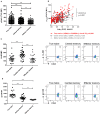IL-6 Mediated Transcriptional Programming of Naïve CD4+ T Cells in Early Rheumatoid Arthritis Drives Dysregulated Effector Function
- PMID: 31333666
- PMCID: PMC6618050
- DOI: 10.3389/fimmu.2019.01535
IL-6 Mediated Transcriptional Programming of Naïve CD4+ T Cells in Early Rheumatoid Arthritis Drives Dysregulated Effector Function
Abstract
Objective: We have previously shown that increased circulating interleukin-6 (IL-6) results in enhanced CD4+ T cell signaling via signal transduction and activator of transcription-3 (STAT3) in early rheumatoid arthritis (RA). We tested the hypothesis that transcriptional "imprinting" of T-cells by this mechanism skews downstream effector responses, reinforcing immune dysregulation at a critical, but targetable, disease phase. Methods: We modeled naïve CD4+ T cell exposure to pathophysiological concentrations of IL-6 in vitro, assessing the dynamic transcriptional and functional consequences for downstream effector cells utilizing microarray and flow cytometry. Fresh blood from treatment-naïve early arthritis patients was phenotyped in parallel for comparison. Results: T cell sensitivity to IL-6 was most marked in the naïve subset, and related to gp130 rather than IL-6R expression. Exposure of healthy naïve CD4+ T cells to IL-6 induced the same STAT3 target genes as previously seen to discriminate RA patients from disease controls. After TCR stimulation IL-6 pre-exposed cells exhibited enhanced proliferative capacity, activation, and a propensity toward Th1 differentiation, compared to non-exposed cells. An entirely analogous phenotype was observed in early RA compared to control CD4+ T cells. Conclusions: Sustained IL-6 exposure at a critical point in the natural history of RA "primes" the adaptive immune system to respond aberrantly to TCR stimulation, potentiating disease induction with implications for the optimal timing of targeted therapy.
Keywords: CD4+ T cell; early rheumatoid arthritis; interleukin-6; pathogenesis; transcriptional programming.
Figures





Similar articles
-
IL-6-driven STAT signalling in circulating CD4+ lymphocytes is a marker for early anticitrullinated peptide antibody-negative rheumatoid arthritis.Ann Rheum Dis. 2016 Feb;75(2):466-73. doi: 10.1136/annrheumdis-2014-205850. Epub 2015 Feb 3. Ann Rheum Dis. 2016. PMID: 25649145 Free PMC article.
-
Expression of STAT3-regulated genes in circulating CD4+ T cells discriminates rheumatoid arthritis independently of clinical parameters in early arthritis.Rheumatology (Oxford). 2019 Jul 1;58(7):1250-1258. doi: 10.1093/rheumatology/kez003. Rheumatology (Oxford). 2019. PMID: 30753680 Free PMC article.
-
Reporters of TCR signaling identify arthritogenic T cells in murine and human autoimmune arthritis.Proc Natl Acad Sci U S A. 2019 Sep 10;116(37):18517-18527. doi: 10.1073/pnas.1904271116. Epub 2019 Aug 27. Proc Natl Acad Sci U S A. 2019. PMID: 31455730 Free PMC article.
-
Effector Functions of CD4+ T Cells at the Site of Local Autoimmune Inflammation-Lessons From Rheumatoid Arthritis.Front Immunol. 2019 Mar 12;10:353. doi: 10.3389/fimmu.2019.00353. eCollection 2019. Front Immunol. 2019. PMID: 30915067 Free PMC article. Review.
-
Review: Transcriptional Regulation of CD4+ T Cell Differentiation in Experimentally Induced Arthritis and Rheumatoid Arthritis.Arthritis Rheumatol. 2018 May;70(5):653-661. doi: 10.1002/art.40398. Epub 2018 Mar 13. Arthritis Rheumatol. 2018. PMID: 29245178 Free PMC article. Review.
Cited by
-
Extracellular vesicles enriched in connexin 43 promote a senescent phenotype in bone and synovial cells contributing to osteoarthritis progression.Cell Death Dis. 2022 Aug 5;13(8):681. doi: 10.1038/s41419-022-05089-w. Cell Death Dis. 2022. PMID: 35931686 Free PMC article.
-
Investigating the molecular mechanism of epimedium herb in treating rheumatoid arthritis through network pharmacology, molecular docking, and experimental validation.Mol Divers. 2025 Jan 16. doi: 10.1007/s11030-024-11019-z. Online ahead of print. Mol Divers. 2025. PMID: 39821498
-
Micro-RNA content of circulating extracellular vesicles in early rheumatoid arthritis as biomarkers and mediators of methotrexate efficacy.Rheumatology (Oxford). 2024 Aug 1;63(8):2259-2267. doi: 10.1093/rheumatology/kead569. Rheumatology (Oxford). 2024. PMID: 37930878 Free PMC article.
-
Classical Signaling and Trans-Signaling Pathways Stimulated by Megalobrama amblycephala IL-6 and IL-6R.Int J Mol Sci. 2022 Feb 11;23(4):2019. doi: 10.3390/ijms23042019. Int J Mol Sci. 2022. PMID: 35216135 Free PMC article.
-
STAT3 phosphorylation in the rheumatoid arthritis immunological synapse.bioRxiv [Preprint]. 2025 Jan 22:2025.01.20.633875. doi: 10.1101/2025.01.20.633875. bioRxiv. 2025. Update in: J Autoimmun. 2025 Jul;155:103456. doi: 10.1016/j.jaut.2025.103456. PMID: 39896614 Free PMC article. Updated. Preprint.
References
-
- Pratt AG, Swan DC, Richardson S, Wilson G, Hilkens CMU, Young DA, et al. . A CD4 T cell gene signature for early rheumatoid arthritis implicates interleukin 6-mediated STAT3 signalling, particularly in anti-citrullinated peptide antibody-negative disease. Ann Rheum Dis. (2012) 71:1374–81. 10.1136/annrheumdis-2011-200968 - DOI - PMC - PubMed
-
- Anderson AE, Pratt AG, Sedhom MA, Doran JP, Routledge C, Hargreaves B, et al. . IL-6-driven STAT signalling in circulating CD4+ lymphocytes is a marker for early anticitrullinated peptide antibody-negative rheumatoid arthritis. Ann Rheum Dis. (2016) 75:566–73. 10.1136/annrheumdis-2014-205850 - DOI - PMC - PubMed
-
- Anderson AE, Maney NJ, Nair N, Lendrem DW, Skelton AJ, Diboll J, et al. . Expression of STAT3-regulated genes in circulating CD4+ T cells discriminates rheumatoid arthritis independently of clinical parameters in early arthritis. Rheumatology. (2019) 58:1250–8. 10.1093/rheumatology/kez003 - DOI - PMC - PubMed
-
- Kuuliala K, Kuuliala A, Koivuniemi R, Oksanen S, Hamalainen M, Moilanen E, et al. . Constitutive STAT3 phosphorylation in circulating CD4+ T lymphocytes associates with disease activity and treatment response in recent-onset rheumatoid arthritis. PLoS ONE. (2015) 10:e0137385. 10.1371/journal.pone.0137385 - DOI - PMC - PubMed
Publication types
MeSH terms
Substances
Grants and funding
LinkOut - more resources
Full Text Sources
Medical
Molecular Biology Databases
Research Materials
Miscellaneous

